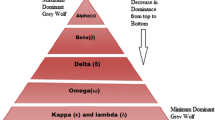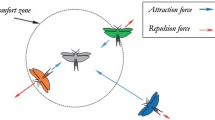Abstract
Ant lion optimizer (ALO) is a newly developed population-based search algorithm inspired by hunting mechanism of antlions and based on five steps of hunting the ants, i.e., the random walk of ants, building traps, entrapment of ants in traps, catching preys and re-building traps. This paper presents the application of ALO algorithm for the solution of non-convex and dynamic economic load dispatch problem of electric power system. The performance of ALO algorithm is tested for economic load dispatch problem of four IEEE benchmarks of small-scale power systems, and the results are verified by a comparative study with lambda iteration method, particle swarm optimization algorithm, genetic algorithm, artificial bee colony, evolutionary programming and Grey Wolf optimizer (GWO). Comparative results show that the performance of ant lion optimizer algorithm is better than recently developed GWO algorithm and other well-known heuristics and meta-heuristics search algorithms.




Similar content being viewed by others
References
Bonabeau E, Dorigo M, Theraulaz G (1999) Swarm intelligence: from natural to artificial systems. OUP, New York
Dorigo M, Birattari M, Stutzle T (2006) Ant colony optimization. Comput Intell Mag IEEE 1:28–39
Kennedy J, Eberhart R (1995) “Particle swarm optimization,” in neural networks, 1995. In: Proceedings, IEEE international conference on, 1995, pp 1942–1948
Kirkpatrick S, Gelatt CD Jr, Vecchi MP (1983) Optimization by simulated annealing. Science 220:671–680
Webster B, Bernhard PJ (2003) A local search optimization algorithm based on natural principles of gravitation. In: Proceedings of the 2003 international conference on information and knowledge engineering (IKE’03), Las Vegas, Nevada, USA, 2003, pp 255–261
Erol OK, Eksin I (2006) A new optimization method: big bang–big crunch. Adv Eng Softw 37:106–111
Rashedi E, Nezamabadi-Pour H, Saryazdi S (2009) GSA: a gravitational search algorithm. Inf Sci 179:2232–2248
Moghaddam FF, Moghaddam RF, Cheriet M (2012) Curved space optimization: a random search based on general relativity theory. arXiv:1208.2214
Kaveh A, Talatahari S (2010) A novel heuristic optimization method: charged system search. Acta Mech 213:267–289
Formato RA (2007) Central force optimization: a new metaheuristic with applications in applied electromagnetics. Prog Electromag Res 77:425–491
Alatas B (2011) ACROA: artificial chemical reaction optimization algorithm for global optimization. Expert Syst Appl 38:13170–13180
Hatamlou A (2012) Black hole: a new heuristic optimization approach for data clustering. Inform Sci
Kaveh A, Khayatazad M (2012) A new meta-heuristic method: Ray Optimization. Comput Struct 112:283–294
Du H, Wu X, Zhuang J (2006) Small-world optimization algorithm for function optimization. In: Advances in natural computation. Springer, pp 264–273
Shah-Hosseini H (2011) Principal components analysis by the galaxy-based search algorithm: a novel metaheuristic for continuous optimisation. Int J Comput Sci Eng 6:132–140
Xue-hui L, Ye Y, Xia L (2008) Solving TSP with shuffled frog-leaping algorithm. In: IEEE proceedings of 8th international conference on intelligent systems design and applications (ISDA’08), Kaohsiung, vol 3, 26-28 Nov 2008, pp 228–232
Fang H, Kim J, Jang J (2011) A fast snake algorithm for tracking multiple-objects. J Inform Process Syst 7(3):519–530
Simon D (2008) Biogeography-based optimization. IEEE Trans Evol Comput 12(6):702–713
Abbass HA (2001) MBO: marriage in honey bees optimization-A haplometrosis polygynous swarming approach. In: Evolutionary computation, 2001. Proceedings of the 2001 congress on, 2001, pp 207–214
Li X (2003) A new intelligent optimization-artificial fish swarm algorithm. Doctor thesis, Zhejiang University of Zhejiang, China
Roth M (2005) Termite: a swarm intelligent routing algorithm for mobile wireless ad-hoc networks
Pinto PC, Runkler TA, Sousa JM (2007) Wasp swarm algorithm for dynamic MAX-SAT problems. In: Adaptive and natural computing algorithms. Springer, pp 350–357
Mucherino A, Seref O (2007) Monkey search: a novel metaheuristic search for global optimization. In: AIP conference proceedings, p 162
Lu X, Zhou Y (2008) A novel global convergence algorithm: bee collecting pollen algorithm. In: Advanced intelligent computing theories and applications. With aspects of artificial intelligence. Springer, pp 518–525
Yang X-S, Deb S (2009) Cuckoo search via Lévy flights. In: Nature & biologically inspired computing, 2009. NaBIC 2009. World Congress on, pp 210–214
Shiqin Y, Jianjun J, Guangxing Y (2009) A Dolphin partner optimization. In: Intelligent systems, GCIS’09. WRI Global Congress on 124–128
Yang X-S (2010) Firefly algorithm, stochastic test functions and design optimisation. Int J Bio-Inspired Comput 2:78–84
Gandomi AH, Alavi AH (2012) Krill Herd: a new bio-inspired optimization algorithm. Communications in nonlinear science and numerical simulation
Pan W-T (2012) A new fruit fly optimization algorithm: taking the financial distress model as an example. Knowl-Based Syst 26:69–74
Khokhar B, Parmar KPS, Dahiya S (2012) Application of biogeography-based optimization for economic dispatch problems. Int J Comput Appl (0975 – 888) 47(13):25–30
Sinha, Nidul, R. Chakrabarti, and P. K. Chattopadhyay. “Evolutionary programming techniques for economic load dispatch.” Evolutionary Computation, IEEE Transactions on 7, no. 1 (2003): 83-94
Gaing Zwe-Lee (2003) Particle swarm optimization to solving the economic dispatch considering the generator constraints. Power Syst IEEE Trans 18(3):1187–1195
Chiang Chao-Lung (2005) Improved genetic algorithm for power economic dispatch of units with valve-point effects and multiple fuels. Power Syst IEEE Trans 20(4):1690–1699
Devi, Lakshmi A, Vamsi Krishna O (2008) Combined economic and emission dispatch using evolutionary algorithms-A case study. ARPN J Eng Appl Sci 3(6): 28–35
Kumar, Sathish K, Rajaram R, Tamilselvan V, Shanmugasundaram V, Naveen S, Mohamed Nowfal Hariharan IG, Jayabarathi T (2009) Economic dispatch with valve point effect using various PSO techniques. 2(6):130–135
Singh L, Dhillon JS (2009) Cardinal priority ranking based decision making for economic-emission dispatch problem. Int J Eng Sci Technol 1(1):272–282
Duman S, Güvenç U, Yörükeren N (2010) Gravitational search algorithm for economic dispatch with valve-point effects. Int Rev Electr Eng 5(6):2890–2895
Bhattacharya A, Chattopadhyay Pranab Kumar (2010) Solving complex economic load dispatch problems using biogeography-based optimization. Expert Syst Appl 37(5):3605–3615
Bhattacharya A, Chattopadhyay PK (2010) Application of biogeography-based optimization for solving multi-objective economic emission load dispatch problems. Electric Power Components and Systems 38(3):340–365
Rayapudi SR (2011) An intelligent water drop algorithm for solving economic load dispatch problem. Int J Elect Electron Eng 5(2):43–49
Pandi V (2011) Ravikumar, and Bijaya Ketan Panigrahi. “Dynamic economic load dispatch using hybrid swarm intelligence based harmony search algorithm.”. Expert Syst Appl 38(7):8509–8514
Swain RK, Sahu NC, Hota PK (2012) Gravitational search algorithm for optimal economic dispatch. Procedia Technology 6:411–419
Yang Xin-She (2012) Seyyed Soheil Sadat Hosseini, and Amir Hossein Gandomi. “Firefly algorithm for solving non-convex economic dispatch problems with valve loading effect.”. Appl Soft Comput 12(3):1180–1186
Rajasomashekar S, Aravindhababu P (2012) Biogeography based optimization technique for best compromise solution of economic emission dispatch. Swarm Evolu Comput 7:47–57
Güvenç U, Sönmez Y, Duman S, Yörükeren N (2012) Combined economic and emission dispatch solution using gravitational search algorithm. Scientia Iranica 19(6):1754–1762
Adriane BS (2013) Cuckoo search for solving economic dispatch load problem. Intell Cont Autom 4:385–390
Wang L, Li L (2013) An effective differential harmony search algorithm for the solving non-convex economic load dispatch problems. Int J Electr Power Energy Syst 44(1):832–843
Dubey, Hari Mohan, Manjaree Pandit, B. K. Panigrahi, and Mugdha Udgir. “Economic Load Dispatch by Hybrid Swarm Intelligence Based Gravitational Search Algorithm.” Int J Intell Syst Appl (Ijisa) 5(8) (2013):21–32
Ravi CN, Christober Asir Rajan C (2013) Differential Evolution technique to solve Combined Economic Emission Dispatch. In: 3rd international conference on electronics, biomedical engineering and its applications (ICEBEA’2013) January, pp 26–27
Gopalakrishnan R, Krishnan A (2013) An efficient technique to solve combined economic and emission dispatch problem using modified Ant colony optimization. Sadhana 38(4):545–556
SECUI, Dinu Călin, Gabriel Bendea, and Cristina HORA. “A Modified Harmony Search Algorithm for the Economic Dispatch Problem.” Studies in Informatics and Control 23, no. 2 (2014): 143-152
Kherfane RL, Younes M, Kherfane N, Khodja F (2014) Solving economic dispatch problem using hybrid GA-MGA. Energy Procedia 50:937–944
Aydin D, Ozyon S, Yaşar C, Liao T (2014) Artificial bee colony algorithm with dynamic population size to combined economic and emission dispatch problem. Int J Electr Power Energy Syst 54:144–153
Thao, Nguyen Thi Phuong, and Nguyen Trung Thang. “Environmental Economic Load Dispatch with Quadratic Fuel Cost Function Using Cuckoo Search Algorithm.” International Journal of u-and e-Service, Science and Technology 7, no. 2 (2014): 199-210
Mirjalili S, Lewis A (2014) Adaptive gbest-guided gravitational search algorithm. Neural Comput Appl 25(7–8):1569–1584
Dhillon JS, Kothari DP (2010) Power system optimization, 2nd edn. Prentice Hall India, New Delhi
Mirjalili S, Mirjalili SM, Lewis A (2014) Grey Wolf Optimizer. Adv Eng Softw 69:46–61
Mallikarjuna B, Harinath Reddy K, Hemakeshavulu O (2014) Economic load dispatch with valve-point result employing a binary bat formula. Int J Elect Comput Eng (IJECE) 4(1):101–107 (ISSN: 2088-8708)
Mirjalili S (2015) The Ant Lion Optimizer. Adv Eng Softw. doi:10.1016/j.advengsoft.2015.01.010
Wood AJ, Wollenberg BF (1996) Power generation, operation and control, 2nd edn. Wiley, New York
Kamboj VK, Bath SK, Dhillon JS Solution of non-convex economic load dispatch problem using Grey Wolf Optimizer. Neural Comput Appl. doi:10.1007/s00521-015-1934-8
Mirjalili S, Mirjalili SM, Hatamlou A (2015) Multi-verse optimizer: a nature-inspired algorithm for global optimization. Neural Comput Appl. doi:10.1007/s00521-015-1870-7
Mirjalili S (2015) Dragonfly algorithm: a new meta-heuristic optimization technique for solving single-objective, discrete, and multi-objective problems. Neural Comput Appl. doi:10.1007/s00521-015-1920-1
Acknowledgments
The authors wish to thank Dr. Seyedali Mirjalili, Professor, School of Information and Communication Technology, Griffith University, Nathan, Brisbane, Australia, for their continuous support for implementing the ALO algorithm for economic load dispatch problem and Dr. J.S. Dhillon, Professor, Sant Longowal Institute of Engineering and Technology, Punjab (India), for their guidance, continuous support and encouragement and DAV University, Jalandhar, for providing advanced research facilities during research work.
Author information
Authors and Affiliations
Corresponding author
Appendix
Appendix
% MATLAB codes for the function B proposed by Seyedali Mirjalili [59]
function [M Ant, M Antlion] = B(M Ant, M Antlion)
for i = 1: n
Antlion = RouletteWheelSelection (M Antlion, 1/MOAL)
Update c and d using Eqs. (13) and (14)
c = Antlion + c
d = Antlion + d
celite = Elite + c
delite = Elite + d
for j = 1: d
R A = normalize(R A , c, d)
R E = X(t)
R E = normalize(RE, Celite,delite)
M Ant (i,j) = (R A + R E )/2
end
end
M OA = FitnessFunction(MAnt)
M combined = concanenation of M Ant and M Antlion
M combined = sort(Mcombined)
M Antlion = the first n rows of Mcombined
If fintessfunction(M Antlion(1,:)) < f(Elite)
Elite = M Antlion(1, :)
end
Rights and permissions
About this article
Cite this article
Kamboj, V.K., Bhadoria, A. & Bath, S.K. Solution of non-convex economic load dispatch problem for small-scale power systems using ant lion optimizer. Neural Comput & Applic 28, 2181–2192 (2017). https://doi.org/10.1007/s00521-015-2148-9
Received:
Accepted:
Published:
Issue Date:
DOI: https://doi.org/10.1007/s00521-015-2148-9




